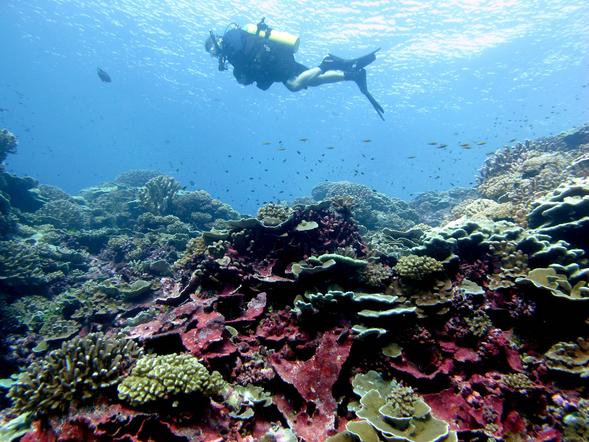We Share a Molecular Armor with Coral Reefs
A new study finds corals and humans utilize the same inflammation-causing molecule, indicating its been a part of immune systems for a half-billion years.

“Despite the complexity of our immune system, a lot of the same things have been going on for 550 million years.”
Coral reefs face many threats. Ocean acidification, algal takeover caused by overfishing and exploding populations of harmful microbes all jeopardize the health of the world’s most productive and diverse marine ecosystems.
The reefs are not defenseless, however. Like humans, they have a type of immune system that helps protect them. A new study published today in the Proceedings of the Royal Society B has found that one particular molecule found in reef ecosystems plays a similar immunological role in corals as it does in humans. From an evolutionary standpoint, this suggests the molecule’s immune function dates back at least 550 million years.
Researchers set out to catalog the molecular makeup of coral reef ecosystems as part of the National Geographic Society’s Pristine Seas project. The underlying goal of this project is to better understand the dynamics of healthy ocean ecosystems.
“Our oceans are rapidly declining and we need to understand what’s normal before there’s no ‘normal’ left,” said the study’s lead author, Rob Quinn, who conducted the research as a postdoctoral scholar at San Diego State University. “We need to find out what healthy reefs look like so we can identify those transitioning to unhealthy.”
Quinn, along with SDSU biology professor Forest Rohwer, Mark Vermeij of the Caribbean Research and Management of Biodiversity foundation, and other colleagues, analyzed coral tissue samples that had been collected from coral reefs off the Southern Line Islands in the central Pacific Ocean, about 2000 km south of Hawaii. These coral reefs are considered among the most remote and pristine reef systems in the world.
Quinn analyzed the molecular contents of the tissue samples with a technique called mass spectrometry, which uses coordinated ion beams to sort out the individual molecules present. Looking at the readout, one molecule in particular stood out to him: platelet activating factor, or PAF.
“It was basically the most abundant molecule we detected in coral,” said Quinn, who is currently at the Skaggs School of Pharmacy and Pharmaceutical Sciences at the University of California, San Diego.
In humans and in other species, PAF is known as a critical component of the immune system. It triggers inflammation, which is a key process in bringing in protective immune cells to fight off pathogens.
Quinn then looked at the molecular and genomic makeup of tissue from corals competing with algae in the Southern Line Islands. Using genetic sequencing technology, the research team found that PAF and the genes responsible for its production were more abundant when the coral was being damaged by its algal competitors. That suggests that PAF production is a stress response activated when coral competes with algae, and that the coral’s immune system was responding in much the same way as a human body fighting an infection.
Researchers estimate that the evolutionary lineages of corals and humans diverged about 550 million years ago. It’s likely that PAF arose as an immunological molecule around that time and it has been functioning in various species’ immune systems ever since.
“Despite the complexity of our immune system, a lot of the same things have been going on for 550 million years,” Quinn said.
Knowing what PAF levels look like in healthy and unhealthy coral reefs could provide oceanographers with a biomarker for these ecosystems’ health, he added.



